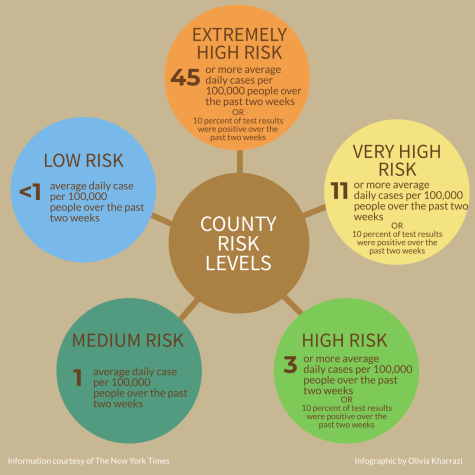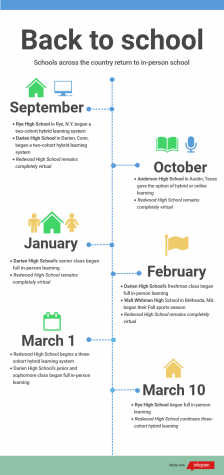Your donation will support the student journalists of Redwood High School. Your contribution will allow us to purchase equipment and cover our annual website hosting costs.
High school education in America: a hybrid of learning opportunities
April 5, 2021
After a year of awaiting a return to normalcy, students received the long-anticipated announcement that Redwood would switch to 100 percent in-person learning starting April 13, 2021. This message provoked mixed emotions, whether it be excitement to once again walk through the hallways, fear of getting the virus or concern about how the new learning model would operate. Students are now adjusting from rolling out of their beds and into their desk chairs to pulling into their parking spaces and walking to class.

While this is a shocking change to Tamalpais Union High School District (TUHSD) students, many teens across the country are already well-adjusted to in-person learning. Some high schools in Maryland and Pennsylvania continue to learn remotely, high schools in Texas have a hybrid system in place and students in Connecticut and New York are learning completely in-person.
Maryland
Kathyrn Stearns is a junior at Walt Whitman High School (WWHS) in Bethesda which is part of the Montgomery County Public Schools District. Like Redwood, WWHS has about 2,000 students who have been learning virtually for the entire school year.
WWHS was supposed to go back to in-person school in January, but the return date has been repeatedly pushed back. Stearns attributes this to the rise in COVID-19 numbers in her area. Montgomery County is classified as “high risk” by the New York Times and Resolve to Save Lives risk level assessment, with 11 cases per 100,000 people.

The school district developed a health metrics grid with the Centers for Disease Control and Prevention’s (CDC) guidelines to determine when in-person learning could resume. Once allowed, WWHS plans on bringing back students by grade level with seniors first. According to a community update on March 24, the school board is streamlining the process of returning by bringing back grades 7-11 all by April 19. However, Stearns claims that the plans for returning are still unclear.
According to Stearns, teachers are required to return to school, and most are willing to do so because of the difficulty of teaching online. Even though teachers got the vaccine without assistance from the school in February, Stearns claims that the administration has handled the situation well in regard to student learning.
“It’s my first year [at WWHS], so I don’t really know the lowdown [of] what they usually do, but [I would say] they’ve been helpful. They send out emails, and they make it easy to meet with your teachers for extra help,” Stearns said.
Separate from academics, WWHS started all of their Fall sports on Feb. 29. Stearns’ field hockey team began practicing while following COVID-19 guidelines, and in mid-March, teams were able to scrimmage with other schools in Bethesda.
Pennsylvania

The Julia Reynolds Masterman Laboratory and Demonstration School is a grade 5-12 public school in the School District of Philadelphia. Philadelphia County has consistently been classified as “very high risk,” with an average of 27 cases per 100,000 people. While there is still no plan for high school students’ return to in-person learning, as of March 1, the district announced a plan to have all students in grades 3-5 and complex needs students in grades 6-8 to begin hybrid learning on April 26th. With high school students still virtual, to ensure a safe return, Principal Jessica Brown explains that they had to cater to both the students’ and the teachers’ needs.
“At this point, there’s a mediator that is talking to the school district and the union around if it’s safe to go back into school because there was an agreement that certain [safety regulations] had to be in place,” Brown said.
The traditional architecture of the school buildings is also a concern, according to Brown, because most of the local schools are over 70-years-old. The lack of funding makes following COVID-19 guidelines challenging.
“There are questions around how all [of] these buildings are safe in terms of ventilation, and whether the [CDC’s] guidelines will be able to be implemented in [our] schools with social distancing,” Brown said.
Additionally, Brown points out how, with a student population of 1,200, the Masterman School is already over the buildings’ student capacity by 400 students, making it even more difficult to bring students back safely.
“We use the library for two classrooms and the cafeteria for two classrooms,” Brown said. “So you can see the concern around the capacity and how we would put all of our guidelines in place.”
The School District of Philadelphia created a policy and protocol book, including COVID-19 testing and classroom guidelines. Teachers are eager to return to teaching in the classroom safely, according to Brown.
“It’s not that educators don’t want kids inside the school, but the safety of everything that goes along with it is really a challenge,” Brown said. “And that’s what we want: safety.”
Texas
Junior Hannah Cukierman is a student at Anderson High School in Travis County, Austin. The school has about 2,200 students and is part of the Austin Independent School District. Travis County is considered a “high risk” area with an average of eight daily cases per 100,000 people. Since late fall, Anderson High School has offered both online and hybrid learning to the general population, while select students with learning needs, such as a failing grade, have been able to return to full in-person learning. Cukierman has opted to continue online instruction due to safety concerns.

“I don’t really think it’s the best idea for [the school] to be offering fully in-person learning, especially for their teachers. But, I guess it’s not my place to attack them, even though I did send my superintendent an email [explaining my concerns],” Cukierman said.
Cukierman says that the administration does not communicate well with their students, especially about sports protocol, which is continuously changing. Additionally, she says that the COVID-19 regulations for sports were not heavily enforced on her tennis team and even less so with contact sports such as basketball.
“[The administrators] think [not enforcing safety regulations] is fine, which it’s not, because they’re putting a lot of kids in danger,” Cukierman said.
According to Cukierman, teachers are also put in jeopardy because the district is forcing them to teach in-person unless they have an existing medical condition. As a result, some quit to avoid the risk of spreading COVID-19 to family members with medical issues.
Cukierman says that Texas, in general, is not safe with its guidelines. To her point, on March 10, Gov. Greg Abbot allowed all businesses to open at full capacity and ended the mask mandate. Texas is one of the first states to lift these restrictions.
Connecticut
Emma Kinnie, a junior at Darien High School in Fairfield County, has been attending school in a hybrid learning model since the beginning of the 2020-2021 school year. On March 1, the option of full in-person instruction was available for all high school students. Fairfield County is at a “very high risk” level for COVID-19 cases, with an average of 35 reported cases per 100,000 people. Kinnie and her peers were used to the small class sizes in hybrid learning, causing many students to feel overwhelmed and question the safety upon their return to in-person instruction.

“Personally, I [feel safe] because I’m vaccinated since I’m an Emergency Medical Technician. But I know some of my friends who have stricter parents are a little hesitant, as we went from not sitting around anyone to having 30-person classes,” Kinnie said.
Kinnie explains that students are still grouped with their cohorts from hybrid learning, even during full in-person instruction.
“For lunch waves, you eat with your cohort,” Kinnie said. “I think for the seating charts especially, they’ve been trying to put cohorts together on sides of the room because we’ve been with those people [since September], and it is safer to just keep it that way.”
According to the Darien High School COVID-19 dashboard, as of March 28, 24 members of the school community have tested positive, and 331 are in quarantine under the school’s enforced contact tracing guidelines. With these precautions, Kinnie appreciates the efforts that administrators have made to get students back into in-person instruction.
“Given the circumstances and time frame that [the administration] had to figure this out, I think they did a pretty good job. I know that they were hesitant to send high schoolers back, but they [still tried] hard to push us back to in-person [learning],” Kinnie said.
New York
Similar to Darien High School in Connecticut, on March 10, Rye High School in Westchester County, began operating in full in-person learning. Westchester County’s COVID-19 numbers are considered “very high risk,” with an average of 40 cases per 100,000 people. Even with these large numbers, superintendent Eric Byrne supports in-person school with strong safety protocols.
“We believe that the research has supported the move to fully reopening school, coupled with the fact that there’s now a much larger data collection that has shown that there’s very limited transmission within schools. Our own internal data [shows] no transmission within any of our schools since the start of the year,” Byrne said.

While many students choose to learn in the classrooms, 200 out of the 1,100 students, including junior Alence Zion, opted to stay in virtual learning due to safety concerns.
“There is no way that it can be safe with that many people in the classrooms at once,” Zion said. “I know so many people in my grade see people in large groups outside of school and from other schools, so they could easily get COVID-19.”
Although students like Zion have safety concerns, Byrne believes that as vaccine distribution continues, the worries that virtual students have may be lifted.
“We believe that [vaccine distribution] helped to make our staff feel quite comfortable, and it’s another layer of mitigation strategy that we believe is helpful from a safety perspective,” Byrne said.
Even with the added safety, the administration says they support and listen to students who prefer to stay at home by allowing them the option to remain virtual on any given day.
“I think it’s really important that school systems work collaboratively, with the students, parents and teachers in the community,” Byrne said. “As you’re reopening, you want people to feel comfortable enough and safe enough that you can have [beneficial] learning.”

California
Marin County is at “high risk” with 5 cases per 100,000 people. Although this is not many in comparison to Westchester County’s 40 cases per 100,000 and Fairfield County’s 35, those schools have been fully in-person for a while. Yet, Redwood has just announced a switch from hybrid learning to full in-person learning starting on April 13. Meanwhile, the COVID-19 numbers in Bethesda are more similar to Marin County, but they remain learning completely online.
Despite varying COVID-19 numbers and levels of efficiency for getting students back into the classroom, the overarching goal in states across the country is to provide in-person learning opportunities within the constraints of county and district rules. According to The New York Times vaccination rollout map, with 12 percent of people in Texas fully vaccinated, 15 percent in New York, 15 percent in California, 15 percent in Pennsylvania, 16 percent in Maryland and 19 percent in Connecticut, the U.S. is on the right path towards returning to normal. Four out of the six counties we covered have returned to at least partial in-person instruction meaning that there is hope for a complete return to in-person school before the end of this pandemic.
All COVID-19 statistics are from the New York Times, using John Hopkins University case and death data. Information last updated on 3/28/21.